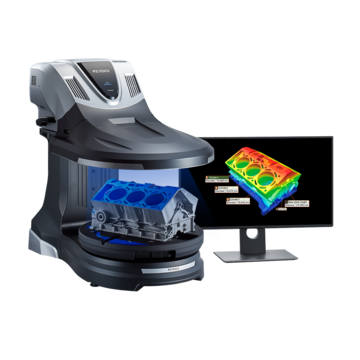Blue Light vs White Light Scanner
When it comes to scanning and digitizing an object with structured light scanners, the choice of light source plays a pivotal role. Blue light and white light 3D scanners represent two distinct approaches to structured-light scanning, each with its set of advantages and applications.
What are Differences between Blue Light vs White Light Scanner?

1.Light Source
- Blue Light Scanner
- Uses a narrow band of blue light wavelengths to illuminate the object being scanned. The specific wavelength used is often in the range of 405 to 450 nanometers.
- White Light Scanner
- Uses a broad spectrum of visible light wavelengths, typically covering the entire visible spectrum from violet to red. This includes wavelengths of blue light as well.
2.Accuracy and Precision
- Blue Light Scanner
- Offers higher accuracy and precision compared to white light scanners. The narrower wavelength range of blue light allows for better control over interference and noise, resulting in more precise measurements.
- White Light Scanner
- Still provides accurate 3D scans, but not to the same level of precision as blue light scanners. The broader spectrum of light used in white light scanning can lead to more interference and potential inaccuracies, especially in complex surfaces or reflective materials.
3.Surface Sensitivity
- Blue Light Scanner
- Better-suited for scanning highly reflective or shiny surfaces. The narrow wavelength range helps reduce specular reflection and glare, allowing for more accurate surface measurements.
- White Light Scanner
- May struggle with highly reflective surfaces, as the broad spectrum of light can cause significant glare and interference. However, modern white light scanning technologies often incorporate advanced algorithms and techniques to mitigate these issues.
4.Speed
- Blue Light Scanner
- Generally, offers faster scanning speeds compared to white light scanners. The focused beam of blue light allows for rapid data acquisition, making blue light scanning ideal for applications requiring high throughput.
- White Light Scanner
- While white light scanners can still achieve fast scanning speeds, they may be slightly slower than blue light scanners due to the broader spectrum of light and potential processing requirements to deal with interference.
5.Cost
- Blue Light Scanner
- Tend to be more expensive than white light scanners, primarily due to their higher precision and specialized technology.
- White Light Scanner
- More cost-effective compared to blue light scanners, making them a more accessible option for many users.
6.Color Reproduction
- Blue Light Scanner
- Due to the narrower spectrum of blue light, blue light scanners may not capture as broad a range of colors as white light scanners. This limitation can result in less accurate color reproduction, particularly for objects with subtle color variations or intricate textures.
- White Light Scanner
- Offers superior color reproduction capabilities due to their broader spectral range, ensuring that a wider range of colors and textures can be faithfully reproduced in the scanned 3D model. This makes white light scanners well-suited for applications where color accuracy is important, such as product design, cultural heritage preservation, and digital art reproduction.
Both blue light and white light 3D scanners have their advantages and limitations. Blue light scanners offer higher precision and are better suited for scanning reflective surfaces, while white light scanners may be more cost-effective and suitable for a broader range of applications. The choice between the two depends on factors such as accuracy requirements, surface characteristics, budget, and intended use.
Related Downloads
Related Products
Scroll



